Stability Testing of Label Adhesives
The stability testing of label adhesives is a crucial step in ensuring that labels adhere effectively and consistently over time. This process involves subjecting the adhesive to various environmental conditions to simulate real-world scenarios, such as temperature changes, humidity exposure, and aging processes.
Adhesive stability is vital for packaging and labeling compliance because it directly impacts product safety and consumer satisfaction. Inadequate adhesion can lead to label peeling or detachment, which not only affects the aesthetic appeal but also poses risks in terms of allergens or harmful substances leaking from packages. Compliance with regulations such as ISO 16283:2017 ensures that products meet international standards for packaging and labeling.
Our stability testing service utilizes state-of-the-art equipment to simulate a range of environmental conditions, including high humidity, direct sunlight exposure, and temperature fluctuations. This approach helps manufacturers identify potential issues early in the product development cycle, allowing them to make necessary adjustments before mass production begins. The data collected from these tests is used to validate that labels will perform consistently under expected use conditions.
For effective stability testing, it’s important to select appropriate specimens for analysis. These can include different types of label materials and adhesives commonly used in consumer product packaging. Specimen preparation plays a critical role; this involves adhering the labels to substrates that mimic actual packaging materials. Once prepared, these samples undergo rigorous testing protocols designed to assess their durability under various conditions.
The instrumentation used for stability testing includes climate chambers capable of maintaining precise temperature and humidity levels over extended periods. These chambers help replicate different climatic zones where end users might encounter the product. Additionally, UV light exposure units are utilized to simulate prolonged sun exposure which could degrade adhesives over time. After exposing samples to these environments, physical properties such as tackiness, cohesion strength, and cohesive failure angle are measured using specialized tools.
Acceptance criteria for successful stability testing depend on specific label designs and intended applications; however, generally accepted standards like ISO 16283 provide guidelines that laboratories must follow when conducting these assessments. Compliance with such standards ensures that results are reliable and comparable across industries.
- Climate chambers
- UV light exposure units
- Specialized measurement tools for assessing physical properties
Why It Matters
The importance of stability testing cannot be overstated when it comes to ensuring product safety and maintaining consumer trust. Non-compliant labels can lead to recalls, legal actions, and reputational damage for manufacturers. By conducting thorough stability tests early in the development process, companies can avoid costly errors down the line.
Consumer expectations are continually rising regarding the quality and reliability of products they purchase. Meeting these demands requires adherence not just to basic manufacturing standards but also rigorous testing procedures like those provided by our laboratory services. Ensuring that label adhesives meet specified performance criteria helps build long-term relationships with customers who expect consistent product performance.
From a regulatory perspective, compliance with relevant international standards (e.g., ISO 16283) is essential for market access and avoiding penalties associated with non-compliance. Our testing services provide objective data that can be used to demonstrate conformity with these regulations, thereby facilitating smoother interactions between manufacturers and regulatory bodies.
Furthermore, stability testing contributes significantly towards sustainability initiatives by helping identify more durable materials and processes that reduce waste throughout the supply chain. By investing in robust testing practices now, companies contribute positively toward creating a more sustainable future.
Scope and Methodology
The scope of our stability testing service includes evaluating various aspects related to the adhesion properties of labels. This encompasses not only the initial attachment strength but also durability over time under different environmental conditions.
Our methodology follows internationally recognized standards such as ISO 16283:2017, which provides comprehensive guidance on how to conduct stability tests effectively. The first step involves selecting suitable specimens that represent typical label designs and materials used in packaging applications.
Once selected, these specimens are subjected to a series of environmental challenges designed to mimic real-world situations such as changes in temperature and humidity levels. Climate chambers play a key role here by allowing precise control over these variables during the test period.
After exposure to varying conditions, physical parameters like tackiness, cohesion strength, and cohesive failure angle are measured using advanced instrumentation available at our laboratory facilities. These measurements provide valuable insights into how well the adhesives hold up under different stressors.
The results from these tests are then analyzed comprehensively before being reported back to clients. Compliance with specified acceptance criteria ensures that only labels meeting required standards pass inspection and can proceed further in the manufacturing process.
Industry Applications
- Pharmaceutical packaging where label integrity is critical for patient safety
- Food & beverage containers where tamper-evident seals enhance consumer trust
- Cosmetics and personal care products requiring clear labeling information
- Electronics manufacturing that relies on durable labels during assembly processes





